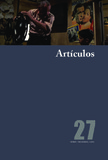Literatura Comparada: perspectivas latinoamericanas con miradas brasileñas

Visualizar/
Data
2020-07-29Autor
Palabras Clave
Literatura Comparada, Entre-lugar, Literatura y Sociedad, Literatura latinoamericana, Transculturalidad, PoscolonialismoComparative Literature, “‘Entre-lugar’- the space-inbetween”, Literature and Society, Latin American Literature, Post colonialism, Transculturality
Metadatos
Mostrar registro completoResumo
La creación de las primeras cátedras de Literatura Comparada (1828) en Francia, a principios del siglo XIX – poco después de la caída de Napoleón Bonaparte (1815) –, abrieron nuevas posibilidades a los estudios literarios. La premisa de verificar las fuentes, influencias, filiaciones y préstamos entre los grandes escritores canonizados establecida en ese primer momento constituye el hilo tradicional de la disciplina. Al expandirse la implantación de esta disciplina académica fuera de los contextos europeos, tal principio no resultó eficiente frente, por ejemplo, a las recientes literaturas producidas en el continente americano. Cambios fundamentales se hicieron necesarios para que la práctica comparatista tuviera, en ese contexto de espacios antes colonizados, un sentido y
una función que no fuera solo la de revelar la dependencia de estas producciones a las canónicas europeas. Nuevas directrices se han desarrollado, especialmente en el espacio latinoamericano, y entre ellas destacamos en ese texto algunas articuladas por estudiosos brasileños como Candido (1965), Carvalhal (1994), Coutinho (1995), Bernd (1998), Nitrini (2000), Santiago (2000), entre otros. Son miradas teóricas brasileñas que posibilitan que la disciplina de Literatura Comparada tenga sentido y función real en el especial espacio del “entre-lugar del discurso latinoamericano”, como defiende Santiago (2000), y aun más en tiempos de poscolonialismo.
Información Adicional
| Otros Títulos | Comparative literature: Latin American perspectives with Brazilian views |
| Correo Electrónico | chicofleck@yahoo.com.br |
| ISSN | 1315-8392 |
| Resumen en otro Idioma | The creation of one of the first cathedras of Compared Literature (1828) in France, in the early 19th Century - soon after Napoleon Bonaparte's downfall (1815) -, opened new study possibilities in the field of Literary Art. The premise of checking sources, influences, filiations and borrowings among the great canonized writers established as goal in this first moment builds up the traditional line of work of the new discipline. With the expanding implementation of this academic discipline throughout the European context, this principle resulted as not effective when, for example, facing the relative recent works of art produced in the American continent. Fundamental adaptations were necessary so that the act of compare would make sense and have a purpose in these formerly colonized nations other than merely revealing the dependence of these productions once compared to the European canonic ones. New guidelines were developed, especially in the Latin American context, and among them we highlight a few ones articulated by Brazilian researchers such as Candido (1965), Carvalhal (1994), Coutinho (1995), Bernd (1998), Nitrini (2000), Santiago (2000), among others. We focus on Brazilian theories that allow the discipline of Comparative Literature to get a real meaning and purpose once practice in the especial “spacein between – ‘entre-lugar’” in which the Latin American discourse is announced, according to Santiago (2000), and even more in the post colonialist age. |
| Colación | 17-41 |
| Periodicidad | Anual |
| País | Venezuela |
| Institución | Universidad de Los Andes |
| Publicación Electrónica | Voz y Escritura. Revista de Estudios Literarios |
| Sección | Revista Voz y Escritura: Artículos |





